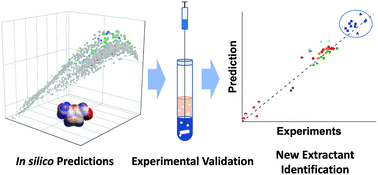Solvent selection for biphasic extraction of 5-hydroxymethylfurfural via multiscale modeling and experiments†
Abstract
We introduce a comprehensive conceptual framework for selecting solvents for reactive extraction in biphasic organic-water systems and demonstrate it for the separation of HMF (5-hydroxylmethylfurfural), a platform chemical produced in the acid-catalyzed dehydration of hexoses. We first perform in silico screening of ∼2500 solvents, from the ADFCRS-2018 database using the ADF COSMO-RS implementation, and classification, based on the solvent partition coefficient. We then determine experimentally the partition coefficients for HMF, fructose, and products of HMF rehydration (levulinic acid (LA), and formic acid (FA)), the mutual water-organic solvent solubilities, and the separation factors in >50 select solvents spanning multiple homologous series at room temperature and a typical reaction temperature with in situ sampling. We find that COSMO-RS is excellent for screening purposes (typical error in most cases within a factor of ∼2). Increased temperatures lead to significant reduction in partitioning, and room temperature measurements are clearly inadequate for solvent selection. Upon down selecting classes of solvents based on separation performance, we perform experimental thermal stability and reaction compatibility studies of a small set of solvents at relevant reactive-extraction temperatures. We discover that many substituted phenols exhibit an order-of-magnitude increase in partitioning compared to conventional solvents due chiefly to hydrogen bond interactions and show the necessary stability but retain a significant fraction of water and LA, factors that need to be considered in technoeconomic analysis. In contrast, anilines, aldehydes, and acids are good to excellent regarding separation but incompatible with this specific reaction medium. This multifaceted framework can be extended to other biomass-derived products and processes.



 Please wait while we load your content...
Please wait while we load your content...